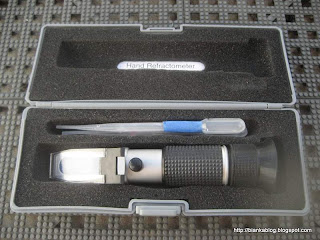While I have not had a problem with winterizing using this method I did have an online discussions with some other sailors about checking to make sure that the after winterizing that the antifreeze was not diluted to the point of being ineffective at the temperatures in my location. Not a bad idea I thought. Some use chemically treated slips of paper that change color to match the level of protection the antifreeze solution is providing. Others use the floating ball gauges and others use an optical hand refractometer.
So I began researching the testing methods. The antifreeze test strips were reasonably cheap around ten bucks for 50 strips. But, then I read they were only reliable for about two years. This might make sense for a boatyard that winterizes a lot of boats but, not for me. They could also give erroneous readings if contaminated. The next device was the floating ball antifreeze testers. Reasonable in price perhaps only ballpark in accuracy.
The third option was the hand refractometer. The most accurate in my opinion but, also the most expensive. In my initial research I saw prices of $120 to $220. Way to expensive to make sense for my wallet.
But, found other antifreeze refractometers for around fifty bucks. Now that's more like it. Even better it has scales for propylene glycol, ethylene glycol and one for checking the charge on flooded lead acid batteries. That's a win, win, win situation in my book so I bought it.
The above photo shows the unit I bought. It comes with two eyedroppers. The one shown here has the blue tape around it to remind me that I only use it to sample distilled water. The little black cap covers the alignment screw should one need to realign the gauge. It also includes the screwdriver in the case. The photo below shows the plastic cover in the open position.

To use this device you open the cover and put a a drop or two of the solution you are testing onto the blueish glass and close the plastic cover to spread the solution onto the glass. You then hold the refractometer up to a lighted area and take a reading by looking into the eyepiece. Here is what you see when you look into the refractometer with no liquid on the glass.
 You have a completely blue field. You can see the three different scales for the propylene glycol antifreeze, battery fluid and ethylene glycol antifreeze. When you open the unit up and drop a few drops of distilled water onto the reading glass this is similar to what you will see when you do a reading:
You have a completely blue field. You can see the three different scales for the propylene glycol antifreeze, battery fluid and ethylene glycol antifreeze. When you open the unit up and drop a few drops of distilled water onto the reading glass this is similar to what you will see when you do a reading:
Notice how it is clear at around 32 degrees F scale. This is how you check the alignment of the device. Note: The photo shows a slightly lower freezing point which may be due to some slight contamination from an earlier test. Cleaning the glass or adjust the alignment screw would correct his offset. But you get the idea. Next the cover was opened the glass cleaned and dried and a drop or two of propylene glycol antifreeze taken from BIANKA's winterized water system was analyzed as shown below:

This shows a freezing point of about 15 degrees Fahrenheit on the propelyne gycol scale. Only 3 degrees "warmer" than the pure antifreeze used to winterize the system. The bursting point for pvc piping according to the manufacturer of the antifreeze should be about - 7 degrees Fahrenheit. Which is "comfortably" below the normal lowest winter temperatures in my area. As they say your mileage may vary or location temperatures may be different. But, using a refractometer to test the antifreeze used to winterize the on board water system will give you peace of mind as you wait for spring to return. Just remember:
"How sad would be November if we had no knowledge of the spring!"- Edwin Way Teale











.jpg)



No comments:
Post a Comment